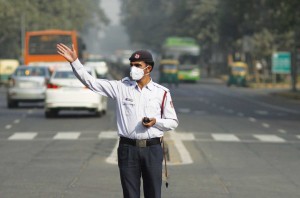The Burden of Pollution
The Odd-Even scheme in Delhi is not producing good results. A holistic approach involving energy, industry and building sectors, together with the transport sector, can only reduce the ambient air pollution
By Dr Manisha Yadav
Despite the odd-even campaign by the Delhi Government, the air quality of the capital city is still not improving. Almost all of the patients are still claiming to be suffering from respiratory problems or chest congestion.

As per report many families with elderly members ailing from respiratory illnesses have installed oxygen cylinders at home for emergency purposes because they can’t keep running to the hospital for every frequent breathing crisis that arises. The medical practitioners feel that the problem needs the attention of not just a single man, but of an entire system, whose combined effort must be to make whole capital city’s air breathable again.
It is important to know how will reducing the number of cars in circulation in a large city reduce ambient air pollution and have a benefit on health and well-being. Although newer motor vehicles have more efficient engines and are using cleaner fuels, the absolute number of vehicles is still increasing in many cities worldwide, and consequently so are levels of ambient air pollution in many urban regions.
For example, in parts of Europe where stricter standards and regulations for vehicles have been enforced, ambient air pollution levels are stable or continue to rise. Per kilometer of travel, diesel vehicles also typically emit more particulate emissions than gasoline, gas-powered, or electric vehicles of comparable size and age so that increased reliance on diesel vehicles in the vehicle fleet may be a contributing factor to health-harmful air pollution in many cities.
Diesel emissions have also been defined by WHO’s International Agency for Research on Cancer as a carcinogen. Building cities around rapid public transport systems, complemented by dedicated walking and cycling networks, is more fuel efficient, in terms of transport. This also tends to facilitate a “virtuous cycle” of more compact cities, more energy efficient housing, fewer private car trips, and thus fewer air pollution emissions overall. This helps minimize the health burden from ambient air pollution – as well as encouraging healthful active transport on safe walking and cycling networks, where people are at less risk of traffic injury.
However, it should be kept in mind that transport may be directly responsible for anywhere from 15 to 70% of urban ambient air pollution in urban areas, depending on the city, but a holistic approach involving energy, industry and building sectors, together with the transport sector, is required to reduce the disease burden from ambient air pollution.
Around 50 percent of people, almost all in developing countries, rely on coal and biomass in the form of wood, dung and crop residues for domestic energy. These materials are typically burnt in simple stoves with very incomplete combustion. Consequently, women and young children are exposed to high levels of indoor air pollution every day. There is consistent evidence that indoor air pollution increases the risk of chronic obstructive pulmonary disease and of acute respiratory infections in childhood, the most important cause of death among children under 5 years of age in developing countries. Evidence also exists of associations with low birth weight, increased infant and prenatal mortality, pulmonary tuberculosis, nasopharyngeal and laryngeal cancer, cataract, and, specifically in respect of the use of coal, with lung cancer. Conflicting evidence exists with regard to asthma.
Exposure to air pollutants is largely beyond the control of individuals and requires action by public authorities at the national, regional and even international levels. The health sector can play a central role in leading a multi-sectoral approach to the prevention of exposure to air pollution. It can engage and support other relevant sectors (transport, housing, energy production and industry) in the development and implementation of long-term policies to reduce the risks of air pollution to health.
Mortality from ischaemic heart disease and stroke are also affected by risk factors such as high blood pressure, unhealthy diet, lack of physical activity, smoking, and household air pollution. Some other risks for childhood pneumonia include suboptimal breastfeeding, underweight, second-hand smoke, and household air pollution. For lung cancer, and chronic obstructive pulmonary disease, active smoking and second-hand tobacco smoke are also main risk factors. These risk factors may contribute to deaths that are caused by ambient air pollution.
Reducing the public health impacts of ambient air pollution requires addressing the main sources of the air pollution, including inefficient fossil fuel combustion from motor vehicle transport, power generation and improving energy efficiency in homes, buildings and manufacturing. Reducing the health effects from ambient air pollution requires action by public authorities at the national, regional and even international levels. Individuals can contribute to improving air quality by choosing cleaner options for transport or energy production.
The public health sector can play a leading role in instigating a multispectral approach to prevention of exposure to ambient air pollution by engaging with and supporting the work of other sectors (i.e. Transport, housing, energy, industry) to develop and implement long-term policies and programs aimed to reduce air pollution and improve health. Indoor air pollution is a major global public health threat requiring greatly increased efforts in the areas of research and policy-making.
Research on its health effects should be strengthened, particularly in relation to tuberculosis and acute lower respiratory infections.

